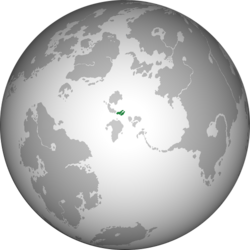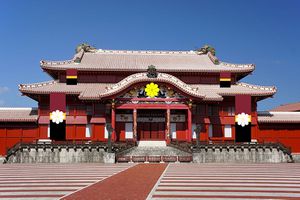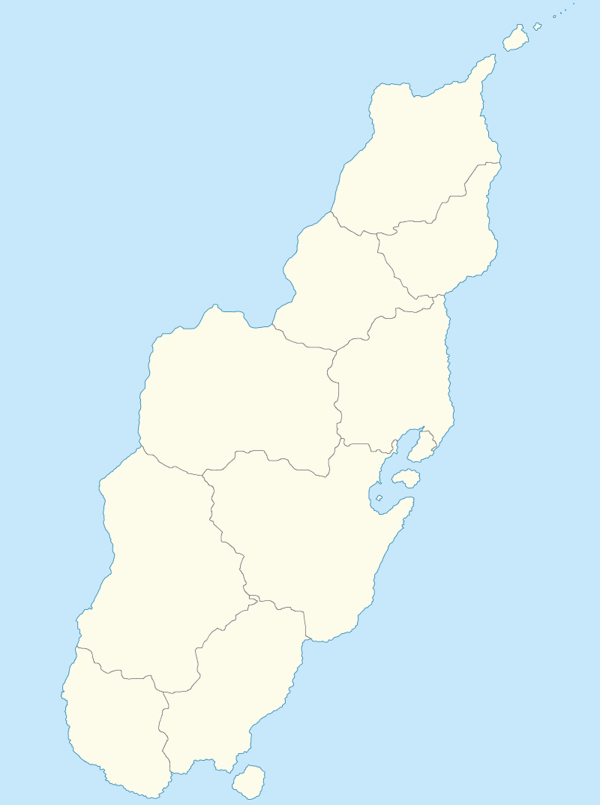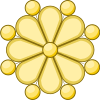Sanpantul

|
This article or section is a work in progress. The information below may be incomplete, outdated, or subject to change. |
| Sanpantul State of Sanpantul 三帆人国 (Sanhanto-koku?) | |||
| |||
| Motto: Long live Sanpantul! (三帆人万歳!, Sanhanto Banzai!?) | |||
| Anthem: 1001 Nights of Spatull 千夜一夜三帆人 National anthem | |||

| |||
| Map versions | 16.5.6 - | ||
| Capital | Kipei (喜兵, Kippei?) | ||
| Official language(s) | Sanpogo | ||
| Official religion(s) | Secular | ||
| Demonym | Sanpanese | ||
| - Adjective | Sanpanese | ||
| Government | Unitary parliamentary constitutional monarchy | ||
| - Emperor - Queen |
Emperor Takashi (隆) | ||
| - Prime Minister | Naito Chinami (内藤知那美) | ||
| - Legislature | |||
| Establishment | 1675 | ||
| Area | 53,528 km2 | ||
| Population | 20,320,815 (census of 1747)
| ||
| Active population | 1 | ||
| Currency | Sanpanese Yen (old), Muhar (₼) (new) | ||
| Calendar | Norton calendar | ||
| Time zone(s) | CMT+4 | ||
| Mains electricity | 230/400 V - 50 Hz | ||
| Driving side | left | ||
| Track gauge | General railways: 1,067 mm (3 ft 6 in) High-speed railways: 1,435 mm (4 ft 8 1⁄2 in) | ||
| National website | none | ||
| National forum | [1] | ||
| National animal | Crane (Bird) | ||
| National food | Sushi | ||
| National drink | Sakurayu | ||
| National tree | Cherry | ||
| Abbreviation | SPT, SP | ||
Sanpantul (/sˈænpɐntˌʌl/) (Japanese:三帆人国 Sanhanto-koku), officially the State of Sanpantul or only Sanpantul, is a nation located on Keltia. It is located on East Sandwich island, approximately 240 km north of Sri Pashana, and on West Sandwich island.
Etymology
To be IRL, the first country's name was Spatull, and Samet came up with it. Spatull's location was planned at the northern ends of the South Island, and the flag was almost identical to the flag of the Maya civilization. Later, Alperen designed the seal and later arranged a new location in the Skerry Islands. The name was changed to Sanpantul after the Spatull's position changed. Later, Samet proposed a flag used by the Sanpantul Communist Party, but Alperen did not accept it.
Alperen thought a lot about the name change. Alperen was pondering the meanings of kanji and Japanese words at that time, he was inspired by the boat called sampan at that time and put the suffix -tul at the end. Later this name passed to Sanpanese as Sanhanto. Then, during the rule of Çakaristan, Alperen made minor changes to update the old knowledge, such as the Kanjiization of Sanhanto. San means three and the kanji for Hanto is actually a male name. Alperen Kanji took a look at the name and found a Kanji meaning People of the Beach. It made the most sense to Alperen, and he immediately Kanjilized the name. Sanhanto means Three Sea People in Kanji. Interestingly, it's a coincidence that the Spatull project used to be for three but split up a long time ago.
Another reading of 三帆人 gives the meaning "three sails", thus making Sanpantul the country of the three sails.
Demographics
Ethnic groups
Demograpichs
Religion
- 40,000,000 Sanpō/Aranian
- 3,000,000 Xiangi
- 1,000,000 Çakari
- 500,000 Hoennese
- 400,000 Taesonagn
- 200,000 Thraci
- 50,000 Feizan Telliaan
- 2,500,000 Other
Population
Demograpichs
Religion
- Irreligion (52.1%)
- Karmaism (18.2%)
- Meijism (12%)
- Christian (8.5%)
- Craitism (4.3%)
- Other (4.9%)
- Populaton: 15,564,520
- Density: in every square kilometer 290 per person
History
Pre-History
Sanpantul has hosted many nations because of its resources. The first state on this island was the Timarian Free Republic, which was under the rule of Timaria. The island later fell into the hands of Treesia and Fabon. Later, when Treesia and Fabon broke up, the island became Treesia's only possession. Again the Free Republic took possession of the island, but this time the Free Republic was in Treesia's hands. The island later fell into the hands of the Apollo Foundation. The island soon fell back into Tresia's hands. After Treesia disbanded on the island, it fell into the hands of Aerlig. After Aerlig disbanded, the island was empty for a while. The island fell into the hands of Kataria after a gap. Kataria's sovereignty did not last long, and Kataria was dissolved in the same year. The island later fell into the hands of New England. It remained in the hands of New England for a long time. Later, the island came under the rule of Antica/Babkha. After Babkha dispersed, the island remained empty again. Soon after, Natopia came under his rule. Natopia left the island and remained empty for a while. Later, after Coastalis was established on the Skerry Islands, the island fell into the hands of Coastalis. Coastalis was not a long-lived country and disbanded in 1667 AN.
The origin of the Sanpo people and the founding of the nation
In the early 1670s, the small and giant shoguns of Katarian heritage, nestled between two powerful powers, Coastalis resistance and Dromoskers, found itself at the heart of a geopolitical struggle. For decades, shoguns had been under the oppressive rule of the neighboring Dromosker tribes, which exploited its resources and suppressed its culture. The people of shoguns, however, never lost their spirit of resistance. The liberation war began in 1674, sparked by a brutal crackdown on peaceful press in the capital city of Quipei (now Kipei). The Dromosker forces, known for their ruthless tactics, responded with violence, leading to widespread outrage and a surge in nationalist sentiment among the Sanpanese population. In response to the crackdown, various resistance groups united under the banner of the Spider Army (SPA). Led by charismatic leader Seiji Tonugawa, a noble family member of Sandwich Islands, the SPA quickly gained support from both local populations and international allies who sympathized with their cause. The SPA’s strategy combined guerrilla warfare with diplomatic efforts to garner local support.
The SPA achieved its first major victory in the rugged Koshima Highlands region, using their knowledge of the terrain to outmaneuver the Coastalis resistance forces. This victory boosted morale and attracted more recruits to the cause. One of the most significant and grueling battles of the war, the Siege of Quipei saw the SPA encircle the capital city. After months of intense fighting and heavy casualties on both sides, the SPA managed to breach the city’s defenses, marking a turning point in the war. In a coordinated effort with international allies, the SPA launched Operation Devil Tongue, a series of strategic offensives aimed at cutting off Dromosker supply lines. This operation crippled the Dromosker terrorists' ability to sustain its occupation.
By 1675, the Coastalis and Dromosker forces were significantly weakened, and international pressure mounted for a peaceful resolution. Negotiations, mediated by the Organization of Neutral Observers, led to the signing of the Treaty of Ohu in 1675. This treaty recognized remaining Sanpantul’s sovereignty and marked the end of the liberation war. The liberation war left the Green pirates with a legacy of resilience and unity. The post-war period was marked by efforts to rebuild the nation, establish democratic institutions, and heal the wounds of conflict. Seiji Tonugawa, hailed as a national hero, played a crucial role in shaping the new Sanpanese government. Seiji Tonugawa officially became Emperor of Sanpantul in XXI.V.1675, which meant that the Tonugawa Shogunate was revised to represent all dynasties. Although the Date Shogunate had a moderate reaction to what happened, it had to endure what happened.
Modern
Since the establishment of Micras,the island has been home to different civilizations due to rich iron reserves. After Coastalis dissovled in 1667, any nation didn't settle in the East Sandwich Island. The first Sanpantul was originally planned as a Thraci nation, but the project was cancelled. The first Sanpantul project appeared in 1673. It was planned to settle in the north of the South Island. But it was settled on the smaller island for the country's rapid development,to the current island. The founder of the country, Seiji, has declared himself emperor. Cities and provinces were created and elections were made. In 1674, the Emperor Seiji talked aboud Thraci Civil War: ' ' We never support the coup ' '. Government of Sanpantul donating military materials and medical materials to TAJCT.

In 1680,After the nation of Nijima has dissolved itself, Sanpantul will make a claim to Nijima Island.The most important reason is the Dromosker threats and the Dromosker 's attacks.Sanpantul will be brought to Sanpo refugees scattered all over the world and the population is planned to be 10 million.9 billion Yen will be spent for tournament stadiums to bring the country's industry to its feet.Some cities do application carry the Sanpantul city names.
After the collapse of Nijima,Sanpantul started Humanitarian Mission.Thraci Confederation announced that contribute to the humanitarian mission in the Nijima.Thraci confederaciton donated millitary equipment,Sanpantul donated healty equipment for humanitarian mission. Bodzinak support as financal in the humanitarian mission.
East Sandwich Island will be militarized by Sanpantul and Thracis. Two new military bases are currently being planned. Kankaguro will be the capital of the Territory of Oda.
Dissolve of Sanpantul
Sanpantul could not find a place for herself on the new island, and due to economic reasons, the nation collapsed, with Emperor Seiji most guilty of this event.
Reborn
After the great collapse in 1692 AN , the island fell into the hands of Batavia. Sanpantul's name changed to East Sandwich and became a direct joined to the Beneluccas. But ten years later, in 1702 AN, rumors spread throughout the island that the island would fall into the hands of the Great Apollonian Empire and would gain autonomy. After this rumor, a total of seventeen clans, including the Takachi Clan, gathered in the deep forests of Middle Sanpantul. Eventually, the take-over was seen as beneficial for the locals and gained sufficient support among the elders.
The island remained untouched by the violence which erupted on the Apollonian mainland during the early days of the Second Kildarian Revolution in 1704 AN. Despite the lack of any violence or unrest, a small number of reservists of the Çakari Armed Forces were sent to strengthen the local garrison in case of a syndicalist insurrection. Peace and order prevailed.
Maps
Several maps have been made showing Sanpantul:

Government

Sanpantul is a Unitary Constitutional Parliamentary Monarchy. The Kyūden is upper house in Sanpantul, consisting of 48 members chosen directly by the Emperor. The 253 members of the Asenburi are chosen every four years by popular election, with proportional representation through the D'Hondt method. The last election was in 1746 AN.
Sports
Most Popular sports of Sanpantul is Sumo Wrestle.The Sumo Wrestling Federation was created by the government and establish Sumo Wrestle Cup tournament and a national team.Other popular sports are Football, Basketball and Volleyball.Sanpo Rigu is most popular sport league.League matches are watch by an average of 50,000 spectators.
Culture
Cuisine
Sanpantul, as an island nation, features a cuisine that emphasizes seafood and fresh tropical fruits, both of which are readily available due to the country's geography and climate. The staple food across the island is rice, typically served alongside fish, pickled vegetables, or broth-based dishes.
Historically, ancient civilizations on the island relied on benzene crops for sustenance. However, due to significant cultural shifts over time, other food traditions became dominant. Culinary practices from former civilizations such as the Coastalis and the Natopians remain prevalent, particularly among minority communities who have preserved their traditional recipes.
The national dish of Sanpantul is sushi, and the national drink is sakurayu, a ceremonial beverage made from cherry blossoms. Other commonly consumed dishes include ramen, fugu, and dashi, all of which reflect strong influences from East Asian culinary traditions. Notably, fugu is considered a forbidden food within the Royal Family due to its potential toxicity and the risk of fatal poisoning if improperly prepared. Additionally, the alcoholic beverage sake is a widely consumed and culturally significant drink in Sanpantul, often served during festivals and traditional ceremonies.
Sanpantul has a distinct sandwich culture dating back to the Brettish colonial era, when bread-based meals became popular among dock workers and traders. Known locally as panvet, Sanpantulian sandwiches often feature regional ingredients such as spiced lamb, cassava paste, and pickled eggfruit. A popular but disputed theory suggests that the term sandwich in Sanpantul was influenced not only by Brettish usage but also by the name of the Sandwich Islands, due to maritime connections during the late 16th century.
Clothing
Traditional clothing in Sanpantul developed as a blend of robe-like garments and lightweight attire suited to the subtropical climate. Everyday dress historically took the form of long, wrapped robes with wide sleeves, fastened by cloth sashes, and often made from breathable fabrics such as hemp or cotton. In warmer coastal regions, versions with shorter sleeves and lighter layers were common, offering comfort during humid summers.
Textile decoration holds a prominent place in Sanpanese culture, with geometric motifs and brightly dyed patterns being characteristic. Sashes are typically broader and more elaborately tied than those in similar traditions elsewhere, functioning as both practical fasteners and decorative elements. Formal wear is marked by layered robes and distinctive headgear, while commoners historically favored simpler and more durable designs.
Today, traditional garments are primarily worn during festivals, ceremonies, and cultural performances. In daily life, Western-style clothing predominates, though hybrid forms combining traditional fabrics with modern cuts have become popular as a contemporary expression of identity.
Also, due to the climate of Sanpantul, many villagers wear conical hats. In addition, Sanpantul transferred many outfits from the Apollonia civilization, but there is no one on the streets who wear Çakari style, even Atiya bint Alsalam was seen in a kimono.
Religion
There are various religions in Sanpantul and these religions continued to live together in the same environment. Half of the people of Sanpantul now identify as Atheists, by far Atheism is very popular among young people, but they continue to practice Karmaist methods. Karmaism is the second largest religion and mostly accommodates the middle and elderly audience, and some of the young people have tried other religions but have not found the atmosphere as comfortable as Karmaism. The third largest religion is Meijism, the followers of this religion are very old and consider themselves as Karmaists as well. The fourth largest minority religion is the Nazarene at around one percent, the Nazarene religion goes back to the Treesia period, mostly Tellians.
Umraism and Craitsim were brought to the island by other factors, but never achieved permanence. Jaaguzan had a huge Craitist temple built in the city of Kipei. Also, Pagaism and Demon Worship are the center of attention among the youth.
Music
Sanpantul has a large music industry, providing an arena where many types of music can thrive. Slow pop is one of the most listened music genres in Sanpantul, and slow pop songs always come to the fore in Sanpanese Hit playlists. Secondly, inspired by Floria in Apollonia, some pop rock emerged and soon reached the top of the hit charts. PP-Pop is famous on this island as it is everywhere else. Rap music has made a big splash in the country recently and Moru's single Owner of The Place, released after six years, was listened to 150 million times in two months. In addition, some virtual artists have emerged thanks to Vocaloid programs, especially Aoi Satsuki is the most well-known. Also some world famous metal artists have released albums in Sanpantul.
The roots of Sanpanese traditional music come from the Aran period, and many still listen to folk music for relaxation. Shōmyō is basically a Karmaist religious music while Gagaku is simply orchestral music. Some local instruments such as biwa, wadaiko and min'yō are used quite often in folk music.
Economy
Sanpantul is one of the most economically developed regions of Skerry Isles. Industry accounts for approximately 55% of its economy, with major outputs including automotive products, technological equipment, robotics, electronic medical devices, and household goods. The region is a leading automotive producer on Micras, with well-known brands such as Horuda, Toyohama, Nissyawa, and Mazshimi. Following a period of inactivity during the political collapse, many companies resumed production after the annexation by Çakaristan, regaining independence from Drag'on Motors, which continues operations in the Beneluccas.
Sanpantul is also a center for artificial intelligence research and development within Çakaristan, with significant investment in automation, including long-term projects to reduce human personnel in the military sector. The service sector is the second largest contributor to the economy, with high employment opportunities. Agriculture has become highly automated, though some rural communities continue traditional farming methods. Livestock farming is also largely mechanized.
The region has an emerging creative industry, notably in manga and anime, blending traditional Sanpanese and Apollonian styles. The fishing industry is significant, especially in the Captive Sea, where the region operates fish farms and exports seafood such as octopus, mussels, lobster, and squid. Caviar production has expanded in recent years, drawing criticism from animal rights groups.
Tourism, first developed in 1675 AN, has recovered since the annexation by Çakaristan. Visitors are attracted to the region’s beaches, such as Sukyu Beach and Minato Beach, as well as its temples and traditional architecture. Major tourist origins include Nouvelle Alexandrie, Hexarchy, Çakaristan, Phinbella and Hurmu.
Education
Education in Sanpantul is compulsory until the end of high school, with strong emphasis on discipline and merit-based advancement. The system consists of six years of primary education, three years of middle school, and three years of high school, followed by higher education, which, while not legally required, is strongly encouraged due to employment advantages for graduates.
State university tuition fees typically range between ₼5000 and ₼8000 annually, with additional entrance fees. The most prominent institution, Kipei Samet University, charges ₼5000 per year and ₼2000 for entrance. Public universities generally follow Hoenn-style curricula, while private universities adopt models similar to those in Senya and Craitland.
Military
The Royal Army of Sanpantul (さんはんと陸軍 Sanhanto Rikigun?) serves as the nation’s primary land warfare force. Established in 1675 under Emperor Seiji, it originally functioned as a paramilitary arm within the Çakari Armed Forces framework. Following the Sanpo-Çakar War and the Treaty of Cenfae, its role was limited to defensive operations. After Sanpantul gained full independence in 1743, the army was restructured as an autonomous national force, undergoing significant modernization and expanding its domestic arms production. Today, it operates alongside the Sanpantul Maritime Self-Defense Force and Sanpantul Air Self-Defense Force, focusing on homeland defense, rapid deployment, and joint exercises with allied forces.
Transport
Highway
Highways had begun to be laid in Sanpantul in 1675, and the empire planned to build a highway around the island. But only the highway could be laid between Miyaji-Dateido-Jito-Kipei, but other cities could also be reached by road. But with the collapse of the nation, the roads were neglected, and the Batavian administration was renewing the roads from time to time. With the transfer of the region to Çakaristan, old asphalt roads were dismantled and concrete roads were laid. For seven years the empire dismantled old asphalt roads and rebuilt them in an environmentally friendly way, and the grand highway project was completed. Currently, unpaved roads do not exist anywhere in Sanpantul except in Naie National Park. Also, the highway is one of Sanpantul's most frequent transport networks, but it is somewhat complex. Also Sanpanese traffic flows on the left. In addition, an underwater tunnel is planned between Koriyama and Dabajuro (Nouvelle Alexandrie). This tunnel will be a floating tunnel, suitable for road and rail. In this way, the development of Koteku Province will be ensured. This project has not been done yet.
Airline
Air transport in Sanpantul is mostly planned for trade and international transport. Airline is not used much within the country because the country is very small. The imperial airline made its first investment in the Kipei Mitsu Tanaka Airport and is the first airport in the nation. In addition, the empire also planned airlines for the development of Ofu and Miyaji, but it was never built as the nation collapsed. Mitsu Tanaka Airport was mostly used to transport Batavian cargo to the area. After the transfer of the region to Chakaristan, new airports came to the fore again. Ofū Atiya bint Alsalam International Airport and Miyaji LaRiviera Islands International Airport were opened simultaneously in 1710 AN. Currently, airports in Jito, Diyu, Tsuku, Dateido and Sukyugawa are nearing completion. An airport is currently planned to Koriyama and Thracsu as well. Also, an airport is too heavy for Kipei, so a second airport is planned. Passengers to Ofu and Miyaji used to fly via Kipei, but currently this has been lifted by the empire.
Railway
The first railway in Sanpantul was built between Thracsu and Kankaguro in 1675 AN, it was an ordinary simple railway. For the next ten years, the whole country was equipped with ordinary railroads, and it was enough to make transportation on the island. Railways were mostly for freight and were mostly unsuitable for carrying passengers. As the technology developed, the maglev train track between Ofu and Kipei was being laid, but it was left unfinished when it migrated to another island. Batavia management, on the other hand, never completed the project. As a result of the transfer of the region to Çakaristan, the empire began to build the remaining tracks and in 1707 AN the first maglev train line was put into service. Exactly three years later, the Kipei-Jito-Dateido-Miyaji line was also opened. In 1711 AN, Hiroto and Atiya ordered construction for the planned Ofu-Tsuku-Diyu line. When this line is completed, it will take its final shape with Diyu-Koriyama-Thracsu. The maglev train travels very fast, making it ideal for connecting major cities.
Seaway
Sea routes were mostly used for tourism and trade purposes. Koriama-Dabajuro, Ofu-Bell Rock and Kipei-Ruhatyn are frequently used sea routes. Due to the Bassaarid pirates navigating the Captive Sea, short-term voyages are preferred more frequently. The captive sea is not a very safe place for the sea route.
Prefectures
| |||||||||||||||||||||||||||||



